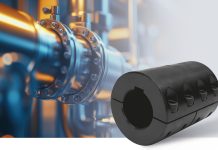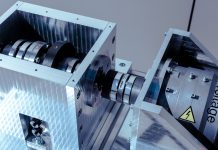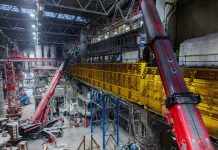The collaboration between Bosch Rexroth and Messina University has given birth to C.E.R.I.S.I., new excellence research centre when the most advanced technologies and systems in Europe will allow the study of seismic events and of all devices and equipment for their prevention.
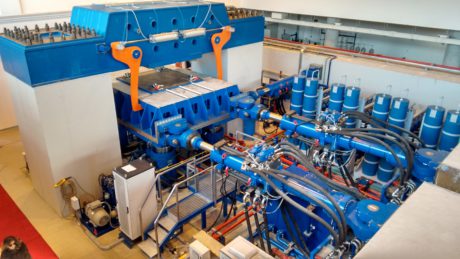
Messina University, established in 1548, is one of the most ancient Italian Universities. Situated inside a territory affected by high seismic risk, struck in the past by disastrous events, is also one of the Italian Centres where researchers coming from all over the world study solutions that allow protecting us from the effects of earthquakes. Studies that today can be carried out on an even wider spectrum, in a further developed laboratory, inaugurated at the end of last year, for whose implementation Bosch Rexroth Italia has played an active and decisive role.
«An upgrading – explained prof. Eugenio Guglielmino, Scientific Manager of the project – that has permitted also the building of new operational premises for the execution of special tests in the ambit of the Structural and Geotechnical Engineering. I am referring in particular to a machine for tests on anti-seismic devices, to a machine for tests on metal cables and to a vibrating table equipped with shear stack for the execution of tests on small-scale models of geotechnical works».
In this context, Bosch Rexroth won the call for tenders for the technical equipment of the three testing and research systems issued by Messina University. In particular, it took part in the implementation of a testing system for supports, dampers and seismic isolators, which allows simulating the motion imposed on site by a seismic event and applying the forces acting on the devices in real scale. Besides, it has manufactured a test bench, dedicated to the testing of a broad range of suspension systems used in the implementation of big infrastructures and a vibrating table, which allows simulating the motion imposed on site by a seismic event and assessing its effects on small-scale models of structures and infrastructures.
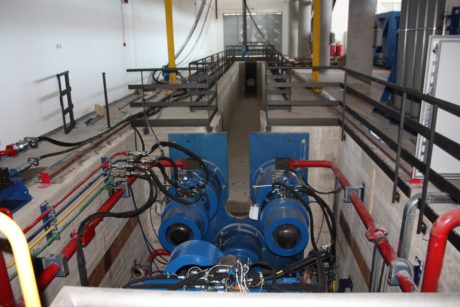
Among the studies in course on a world scale of the solutions that can protect us from seismic events, it turns out to be very promising the one consisting of seismic isolators that, in case of earthquake, damp the vibrations exerted on the foundations: a sort of “shock absorber” for the entire building.
«Until now – explains Mr Giuseppe Ricucci, Project Engineer of Bosch Rexroth Italia – it was possible to test isolators “upside down”, i.e. imposing the building motion induced by the earthquake with apposite hydraulic cylinders»
Actually, earth moves and not the building. Starting from that assumption, some scholars of Messina University conceived the idea of implementing an earthquake simulator that was finally able to test isolators under realistic conditions. Besides the technical plant design, Bosch Rexroth itself took care, in this ambitious project, also of the entire system management and of the global work coordination. Activities that were carried out in record times, in the lapse of slightly more than one year since the task entrustment.
To reach the exacting machine performances, fundamental was also the development of the mathematical models for the simulation that Bosch Rexroth itself faced and the development of the control software. Moreover, the implementation of a scale prototype has also allowed testing different algorithms and optimizing the control system.
Testing system for anti-seismic isolators
Designed and implemented by Bosch Rexroth (according to the indications of the minimal performance parameters that allow executing tests on the almost totality of the production of anti-seismic devices in Europe), the test system for the characterization of passive seismic insulation systems consists of a table with 6 degrees of freedom.
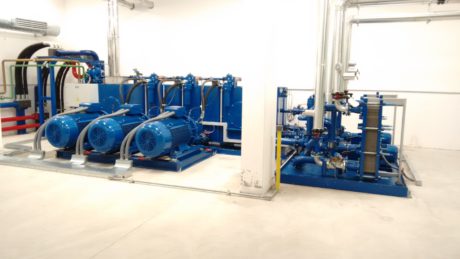
«The machine– explains the engineer Ricucci – is essentially composed by 6 main parts: a table sliding on a hydrostatic film, four vertical actuators for the Z-axis, four horizontal actuators for the X- and-Y axes, an upper metal beam, two reinforced concrete pillars and a system for the hydraulic energy accumulation».
The 4 vertical actuators are based on low-friction hybrid technology, they are equipped with 2 three-way Bosch Rexroth servo-valves with high flow rate and high dynamics: one small, for the retraction chamber and a big one for the extension chamber, instead of a standard 4-way servo-valve.
Still 4 are the actuators for the X- and Y-axes (2 for each axis), executions with double rod, still based on low-friction hybrid technology, connected with the table by backlash-free ball joints. Higher speed X-axis actuators are equipped on-board with 4 Bosch Rexroth high-dynamics parallel servo-valves while the Y-axis ones are provided with 2 servo-valves. Highly performing equipment in terms of dynamics, precision and motion stability. «On each actuator – further adds Mr Ricucci – they have provided also for a small-size servo-valve that, besides executing low-speed motions for the set-up, improves the system precision in the phases of motion inversion or for the control with low loads».
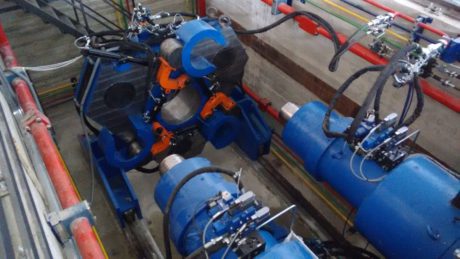
Concerning the accumulation system, due to the high pulse rate of the machine, it was necessary to provide for a hydraulic energy one that, at the highest performances, can (even if for a short time) perform a flowrate in the order of 20,000 litres per minute in a range of variable pressure from 22 to 31.5 MPa.
Earthquake simulation and cable testing system
To simulate the motion imposed on-site by a seismic event and to assess its effects on small-scale models of structures and infrastructures, as already underlined, Bosch Rexroth has implemented an apposite vibrating table with 1.5 x 7 m surface.
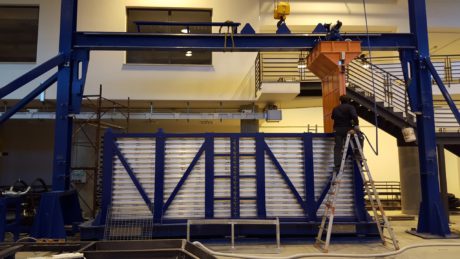
«Peculiar element of this equipment – comments Mr Ricucci – is the presence of a container with deformable walls, called Shear Stack, which, through opportune procedures, is filled with ground. The deformable walls of the container simulate an effect of not-confinement of the earth and allow executing seismic tests that strictly approach reality».
In addition to the two above-mentioned testing devices, at Messina University Bosch Rexroth has implemented another important test bench, dedicated to the testing of a broad range of suspension systems used in the building of big infrastructures, such as suspended and stayed bridges and the big cable transport lines (like for instance cable cars, cableways etc.).
«The most important characteristics of this test bench – highlights Mr Ricucci – consist not only in the exceptional tensile load that can be applied but also in the sizes of the specimen undergoing tests that actually make it a unique device currently available in Europe».
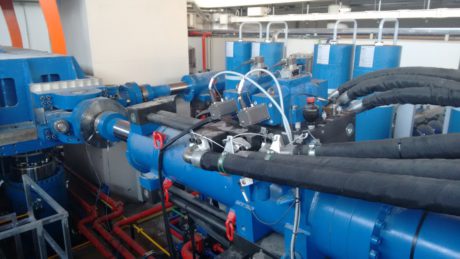
We are referring to a test bench for the mechanical characterization of great-light bridge cables and stays (up to 109 strands for 22 m of length) for fatigue and breaking tests with an axial load of about 34,000 kN. A machine composed by three patented Tandem Bosch Rexroth servo-actuators equipped with load cell and position transducer, a trench with 30.6 metre length and a mobile carriage on which the cable is fixed.
«The operation– explains Mr Ricucci – provides for a static force generated by the major actuator chamber, which can reach 31,000 kN, and a dynamic component superimposed by the minor chamber that can reach 3,100 kN».
Research, development and industrial innovation
An ambitious and unique project in which times, management optimization and highest coordination of the involved players have played a determinant role for the good final result. All that taking also into account some logistic-operational troubles that have involved for instance the organization, too (cared by Bosch Rexroth itself) of two exceptional transports from North Italy to Messina, with the addition of an enormous crane coming from Palermo for the positioning of some elements such as the vibrating table and the contrast beam. An impressive sequence of activities coordinated by the researchers of the Engineering Department and Bosch Rexroth engineers, which last December allowed the inauguration of C.E.R.I.S.I. (Centre of Excellence for the Research and Innovation on large dimensions Structures and Infrastructures).
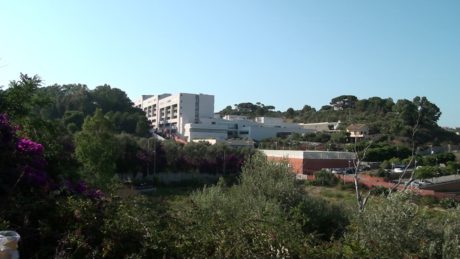
The project, for which were invested 22 million Euros, springs from the cohesion and the inter-exchange of 4 areas of the Scientific Research of Messina: Construction Science and Technique (Manager: Giuseppe Ricciardi), Geotechnics (Manager: Ernesto Cascone), Naval-mechanical engineering (Manager: Vincenzo Crupi) and Earth Science (Manager: Giovanni Randazzo). In addition to the research activity, the Centre is also characterized by the offer of scientific and technological services. The target markets are generally represented by subjects that design, implement, manage and monitor the large infrastructures in the world and by subjects entrusted with the safeguard and protection of environments particularly subjected to seismic events. The main potential customers are all those economic and social players that are called to monitor ex ante, in itinere and ex post the environment and the existing infrastructures, subjected to dangers springing from atmospheric, mechanical and seismic stresses. The Centre of Excellence C.E.R.I.S.I. allows also executing tests in scale 1:1 on large-size structures subjected to real dynamic load conditions while operating. The test equipment of the “Test laboratory for large structures” consists of a frame standing out for high resistance and stiffness. The sizes provided for the gridded floor (15×8 m – h = 0.3 m) and for the frame (9×7 m – h = 5 m) and the performances of the actuators (maximum dynamic force of 1,000 kN for a single actuator) and of hydraulic power units allow performing dynamic tests on big-size components, equipping naval and railway structures, automotive, aeronautics and aerospace. The choice of different typologies of actuators (dynamic performance of: 100 kN, 250 kN, 500 kN and 1,000 kN), with the possibility of applying at least 5 actuators simultaneously and the presence of opportune structures (gridded plan, portal and test benches) allows carrying out very versatile tests on components with various sizes on which can be applied, in definite points, different stresses by amplitude, frequency and imposed displacement.
Sicilian excellence and international innovation
At the presence of the On. Gian Luca Galletti, Ministry of the Environment and the Protection of Land and Sea, last December took place the Ceremony of inauguration of C.E.R.I.S.I. Laboratory, a centre of excellence born from the cohesion of 4 areas of the scientific research of Messina University: Construction Science and Technique, Geotechnics, Naval-Mechanical Engineering and Earth Science What are the reasons that have guided the University in the implementation of this project, what the expectations?
«The core idea – comments prof. Eugenio Guglielmino, Scientific manager of the project – was integrating the University with the entrepreneurial world, highlighting the competences of the academic world outside, providing industries with services and consulting, in an economic context that extends on an international scale».
Starting from the local criticalities, concerning the seismic risk, and with the competences gained in this sector by Messina University, they have developed the Structural Engineering area, implementing in the Eurolab laboratory of C.E.R.I.S.I. machines able to provide services all over the world for the certification and the acceptance of anti-seismic devices (isolators and dissipators).
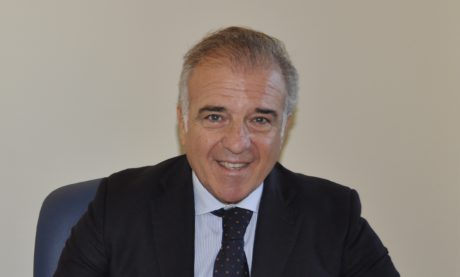
«The market in this sector – goes on prof. Guglielmino – lives a strong expansion, especially in the areas with high seismic risk like California, Japan, China, New Zealand, Turkey and manufacturing companies are very active. Due to a consolidated relationship with the laboratory of S. Diego University, where they have installed a similar machine, we know that the test demand is very high, with wait periods of over two years. This demonstrates that the market is favourable. Addressing also the sector of the construction of large infrastructural works (great-light bridges, cable transport lines, big lifts, editor’s note) we have developed the ambit of tests on cables and stays as well. Like for anti-seismic devices, the demand of executing characterization tests is imposed by building regulations in all Countries in the world».
This grants the market soundness, since, moreover, the availability of these machines in the world is limited (for instance, only 2 other testing machines on anti-seismic devices are present in the world with the same performances as the one operating at C.E.R.I.S.I., as well as the machine for fatigue tests on cable is unique by performances in Europe).
What are the expectations and the growth opportunities after the starting up of the new simulator?
«With these preliminary conditions – ends prof. Guglielmino – expectations are promising. In an Italian context where the available resources for the University world have been drastically reduced, the laboratory will constitute an important resource to allow the Messina University to prosecute its research activity and to give young graduates an additional chance in the labour world. We hope we will further develop C.E.R.I.S.I. with new equipment soon, exploiting other resources coming from the European funds (PON 2014-2020, editor’s note). We are already ready to do that, since we rely on the available enlargement project of the Eurolab laboratory, with all necessary authorizations already attained». www.unime.it

